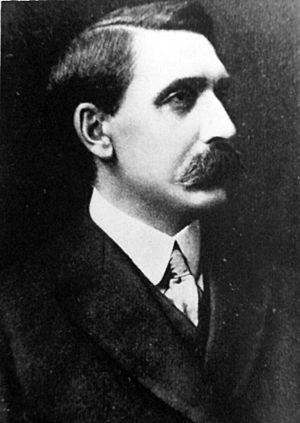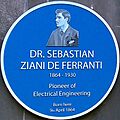Sebastian Ziani de Ferranti facts for kids
Quick facts for kids
Sebastian Ziani de Ferranti
|
|
|---|---|
 |
|
| Born | 9 April 1864 Liverpool, England
|
| Died | 13 January 1930 (aged 65) Zurich, Switzerland
|
| Nationality | British |
| Alma mater | University College London |
| Known for | Ferranti effect |
| Awards | Faraday Medal (1924) |
| Scientific career | |
| Fields | Electrical engineer and inventor |
Sebastian Ziani de Ferranti was a brilliant British electrical engineer and inventor. He was born on April 9, 1864, and passed away on January 13, 1930. He made huge contributions to how we get electricity to our homes today.
Contents
Who Was Sebastian Ziani de Ferranti?
Sebastian Ziani de Ferranti was born in Liverpool, England. His father, Cesare, was a photographer from Italy. His mother, Juliana, was a talented concert pianist.
He went to school in London, including Hampstead School and University College London. He married Gertrude Ruth Ince in 1888. They had seven children together. Sebastian de Ferranti died in Zurich, Switzerland, and was buried in London.
Ferranti's Family Legacy
Sebastian's grandson, Basil de Ferranti, became a politician in the UK. His granddaughter, Valerie Hunter Gordon, was also an inventor. She created what many consider the world's first disposable nappy (diaper). She also designed an early sanitary towel system.
How Ferranti Changed Electricity
Sebastian de Ferranti showed amazing talent for electrical engineering from a young age. When he was just 13, he invented an arc light for street lighting.
Around age 16, he built an electrical generator. This generator had a special "Zig-zag armature." He even patented this device, which was called the "Ferranti Dynamo."
He worked for a company called Siemens Brothers. In 1882, he started his own company in London. It was called Ferranti, Thompson and Ince. They designed many different electrical devices.
The "War of the Currents"
In the late 1880s, there was a big debate in America. This was about the best way to send electrical power. It was known as the "war of the currents."
Thomas Edison believed in a direct current (DC) system. He had many patents for DC technology. The rival company, Westinghouse Electric Corporation, supported an alternating current (AC) system.
Ferranti believed in AC power very early on. He was one of the few experts in this system in the UK.
Building a Modern Power Station
In 1887, the London Electric Supply Corporation (LESCo) hired Ferranti. They wanted him to design their new power station in Deptford.
Ferranti designed the entire station. This included the building, the machines that made electricity, and the system to send it out. When it was finished in 1891, it was the first truly modern power station.
It sent out high-voltage AC power at 11,000 volts. This power was then "stepped down" (reduced) for homes and businesses. This basic system is still used around the world today.
The Ferranti Company
Sebastian de Ferranti's company started in 1885. It later became S. Z de Ferranti Ltd in 1890. Then, in 1900, it became Ferranti Ltd.
This company continued to be very important after its founder passed away. In 1951, Ferranti Ltd developed the Ferranti Mark 1. This was the world's first computer available for sale to the public.
Awards and Recognition
Sebastian de Ferranti was a respected leader in his field. He was President of the Institution of Electrical Engineers in 1910 and 1911. In 1927, he became a Fellow of the Royal Society.
He also received an honorary doctorate from the University of Manchester in 1912. Ferranti helped create the British Electrical and Allied Manufacturers Association (BEAMA) in 1911. He was its first chairman.
Ferranti's Inventions
- "U.S. Patent 341,097 Unipolar dynamo electric machine".
See also
- Vincent Ziani de Ferranti (son)
- Basil de Ferranti (grandson)
- Valerie Hunter Gordon (granddaughter)
- Ferranti effect
- Baslow Hall
Images for kids


